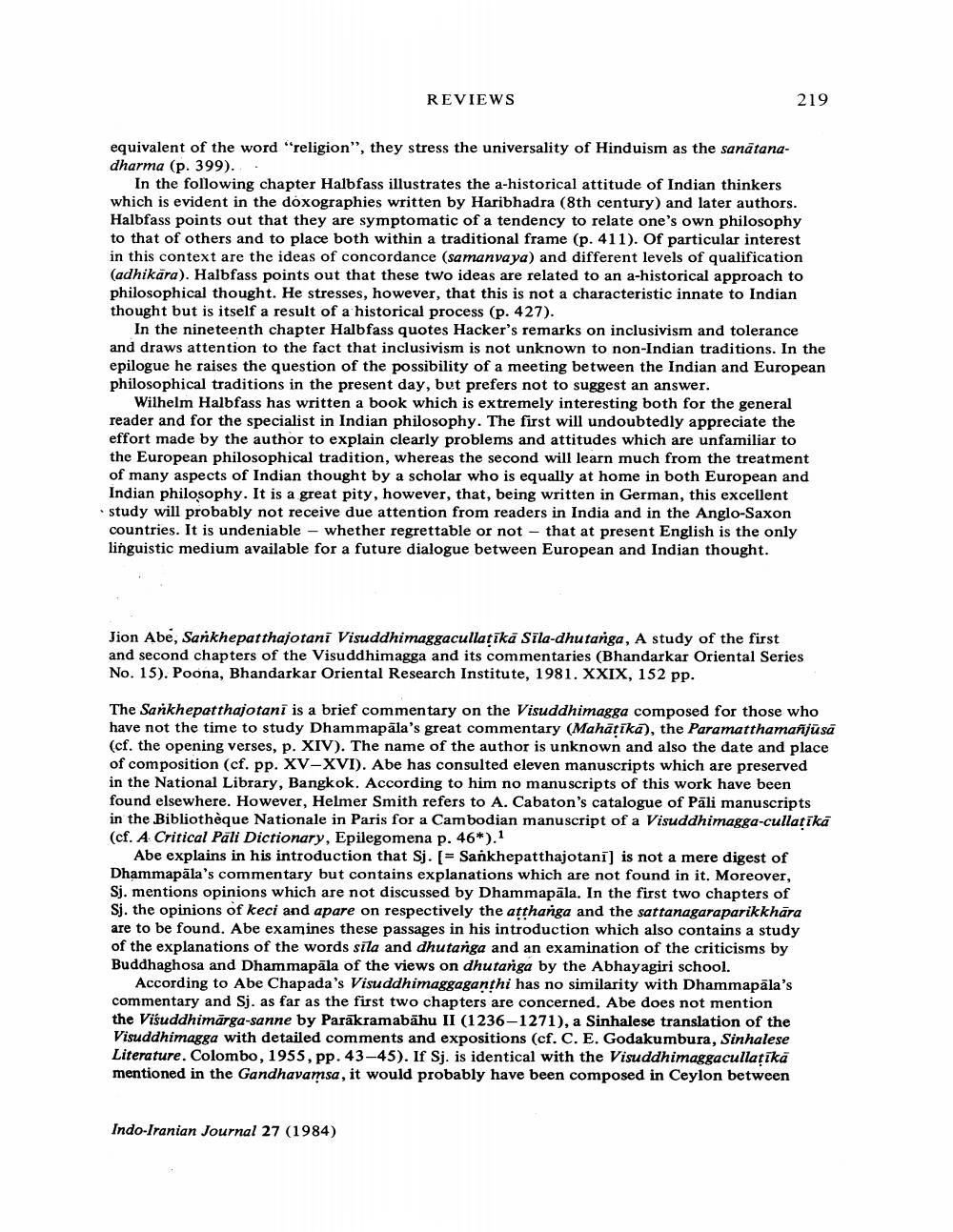________________
REVIEWS
219
equivalent of the word "religion", they stress the universality of Hinduism as the sanātanadharma (p. 399).
In the following chapter Halbfass illustrates the a-historical attitude of Indian thinkers which is evident in the doxographies written by Haribhadra (8th century) and later authors. Halbfass points out that they are symptomatic of a tendency to relate one's own philosophy to that of others and to place both within a traditional frame (p. 411). Of particular interest in this context are the ideas of concordance (samanvaya) and different levels of qualification (adhikāra). Halbfass points out that these two ideas are related to an a-historical approach to philosophical thought. He stresses, however, that this is not a characteristic innate to Indian thought but is itself a result of a historical process (p. 427).
In the nineteenth chapter Halbfass quotes Hacker's remarks on inclusivism and tolerance and draws attention to the fact that inclusivism is not unknown to non-Indian traditions. In the epilogue he raises the question of the possibility of a meeting between the Indian and European philosophical traditions in the present day, but prefers not to suggest an answer.
Wilhelm Halbfass has written a book which is extremely interesting both for the general reader and for the specialist in Indian philosophy. The first will undoubtedly appreciate the effort made by the author to explain clearly problems and attitudes which are unfamiliar to the European philosophical tradition, whereas the second will learn much from the treatment of many aspects of Indian thought by a scholar who is equally at home in both European and Indian philosophy. It is a great pity, however, that, being written in German, this excellent ⚫ study will probably not receive due attention from readers in India and in the Anglo-Saxon countries. It is undeniable whether regrettable or not that at present English is the only linguistic medium available for a future dialogue between European and Indian thought.
Jion Abe, Sankhepatthajotani Visuddhimaggacullaṭīkā Sīla-dhutanga, A study of the first and second chapters of the Visuddhimagga and its commentaries (Bhandarkar Oriental Series No. 15). Poona, Bhandarkar Oriental Research Institute, 1981. XXIX, 152 pp.
Indo-Iranian Journal 27 (1984)
The Sankhepatthajotani is a brief commentary on the Visuddhimagga composed for those who have not the time to study Dhammapala's great commentary (Mahāṭīka), the Paramatthamañjūsā (cf. the opening verses, p. XIV). The name of the author is unknown and also the date and place of composition (cf. pp. XV-XVI). Abe has consulted eleven manuscripts which are preserved in the National Library, Bangkok. According to him no manuscripts of this work have been found elsewhere. However, Helmer Smith refers to A. Cabaton's catalogue of Pali manuscripts in the Bibliothèque Nationale in Paris for a Cambodian manuscript of a Visuddhimagga-cullaṭīkā (cf. A Critical Pali Dictionary, Epilegomena p. 46*).1
Abe explains in his introduction that Sj. [= Sankhepatthajotani] is not a mere digest of Dhammapala's commentary but contains explanations which are not found in it. Moreover, Sj. mentions opinions which are not discussed by Dhammapala. In the first two chapters of Sj. the opinions of keci and apare on respectively the atthanga and the sattanagaraparikkhāra are to be found. Abe examines these passages in his introduction which also contains a study of the explanations of the words sila and dhutanga and an examination of the criticisms by Buddhaghosa and Dhammapala of the views on dhutanga by the Abhayagiri school.
According to Abe Chapada's Visuddhimaggaganthi has no similarity with Dhammapala's commentary and Sj. as far as the first two chapters are concerned. Abe does not mention the Visuddhimarga-sanne by Parakramabahu II (1236-1271), a Sinhalese translation of the Visuddhimagga with detailed comments and expositions (cf. C. E. Godakumbura, Sinhalese Literature. Colombo, 1955, pp. 43-45). If Sj. is identical with the Visuddhimaggacullaṭīkā mentioned in the Gandhavamsa, it would probably have been composed in Ceylon between




